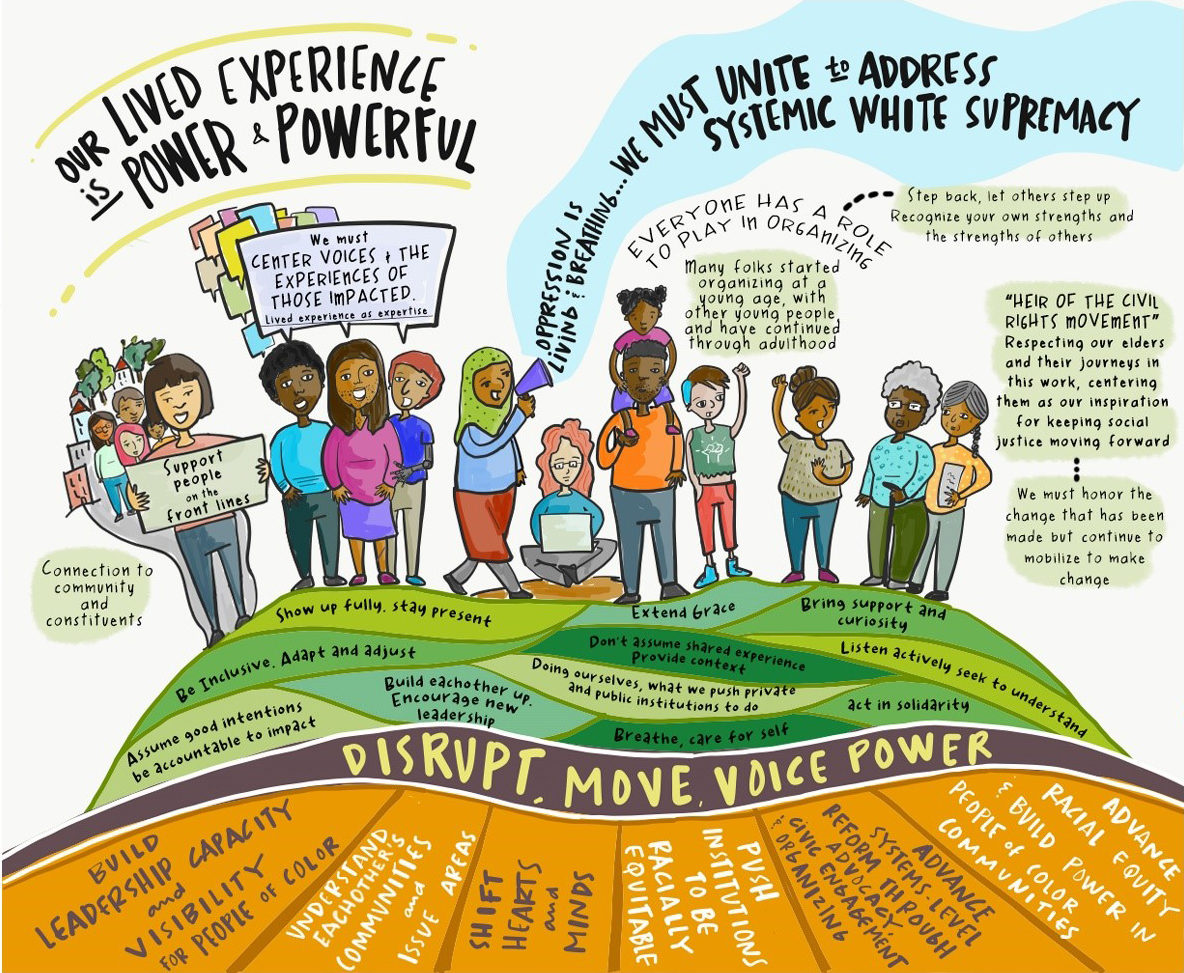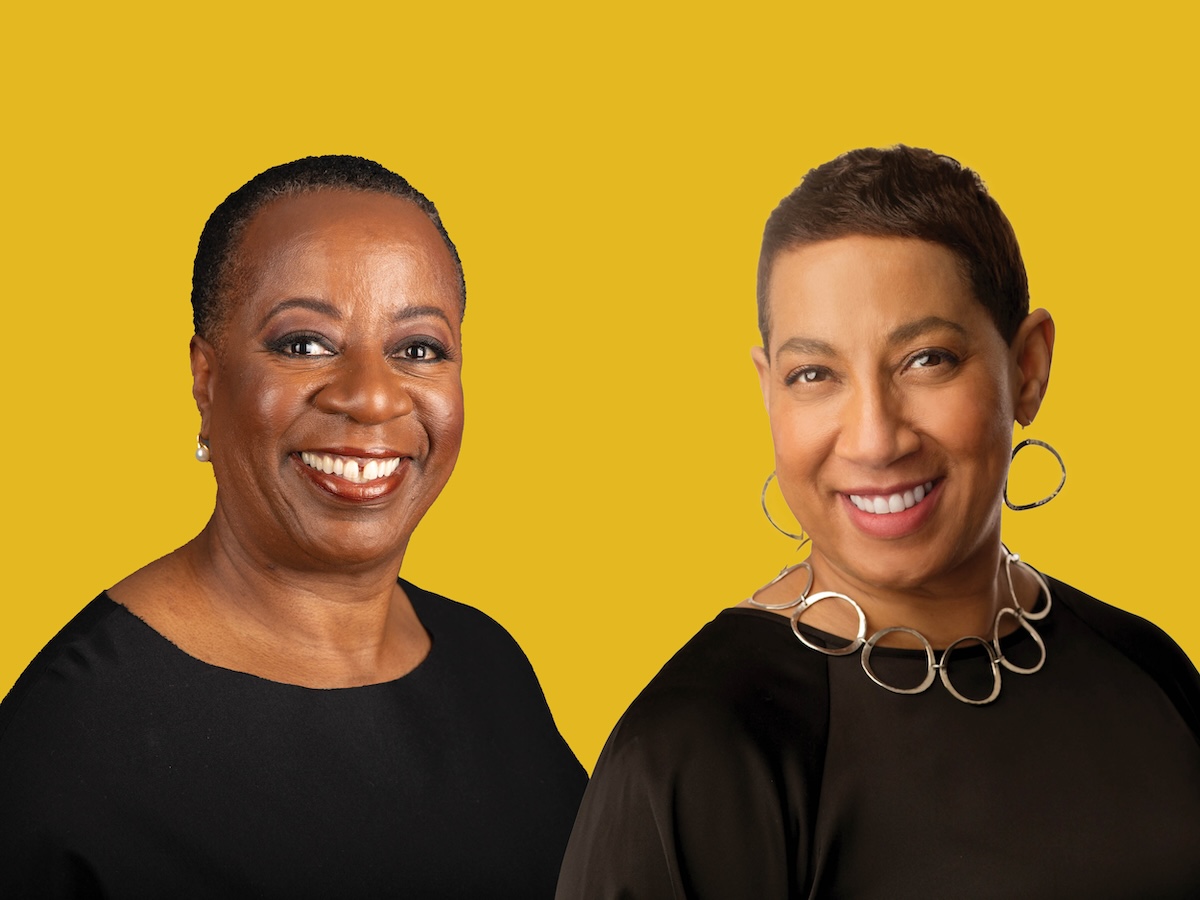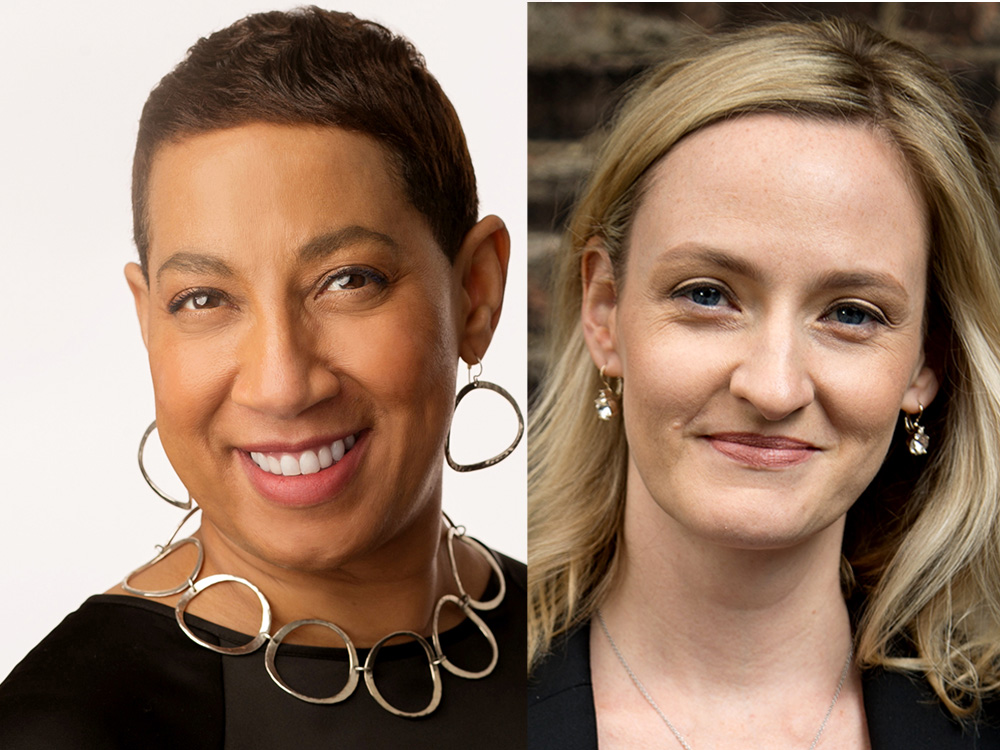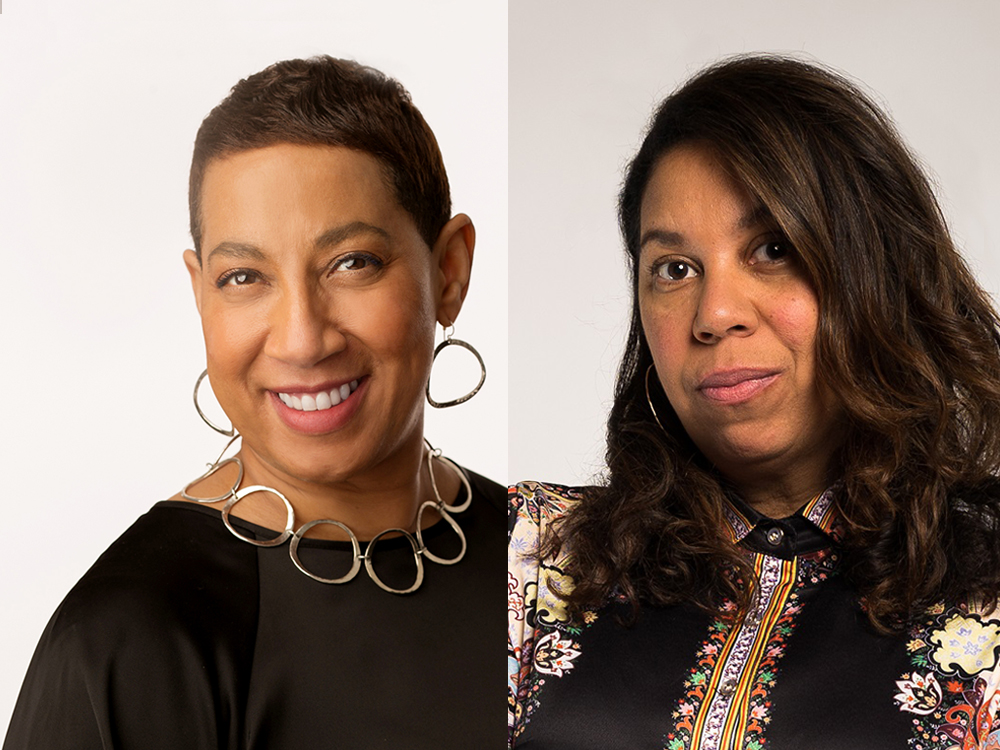
The Journal is excited to launch a conversation series featuring PEAK’s new President and CEO Satonya Fair and members of the PEAK community, speaking one-on-one about top-level, of-the-moment challenges and the operational strategies being deployed to meet them.
In this edition, Fair spoke with Weissberg Foundation Executive Director Hanh Le to find out how they’re operationalizing a re-commitment to racial equity and justice.
In 2017, Weissberg rolled out a strategic framework that centered equity for marginalized populations, revising it in 2019 to “more boldly and explicitly center power-building to dismantle systemic racism.” As the events of 2020 – and in particular, the killing of George Floyd – drove nation-wide attention to the persistence of injustice and inequity for Black people, as well as other communities of color, Weissberg has been able to take an outsized role in the philanthropic sector’s response.
In the conversation below, Le shares the details of their reframed approach, the trust-based practices they’ve put in place, the advocacy work they do with other funders, and more.
Satonya Fair: At the Weissberg Foundation, you have very explicitly centered power-building to dismantle structural racism. That’s a huge opportunity, but it’s also quite a big risk. We wanted to hear from you about this bold step, and how that’s playing out for you.
Hanh Le: People think of it as a risk, and maybe it was – but maybe not how people might think. We at the Weissberg Foundation were probably more a risk to new grantee partners, community partners, and other funding partners who have been in this space long before we were. We’re the new kids coming into it: We were untried.
We needed to build trust for it to work, and also to be aware of past trauma that philanthropy – the Weissberg Foundation ourselves, and certainly philanthropy as a sector – has caused nonprofits. We’re responsible for that. It might lead people not to trust us, and fairly.
Fair: I think that perspective on trust speaks volumes for you as a partner. Can you talk about how you have tried to operationalize that commitment to building trust? How did you bake it into the system?
Le: For us, operating with trust is a matter of both values and practicality. If we truly value people, then we need to engage with trust. Remember that philanthropy literally means “love of humanity.” Trusting someone is demonstrating love. I’m not saying it’s easy – it’s certainly not, because we all bring baggage and biases and other things to relationships.
We think about trust not just externally – with our programs and grantmaking, and our strategies of amplification, building capacity, and collaboration – but also within our staff, within our board, and between them. If we don’t have trust internally, it impacts how we show up in community. We’re a small staff. We have four staff members and seven board members. Operating with trust means being less burdensome, to our grantees and to ourselves, our staff.
Externally, one of the things we did was cut down on reporting that’s only seen by us. If one of our goals is amplifying grantee partners, why don’t we just have them write a blog post? It’s reporting that we can share more broadly in hope of lifting their visibility.
Another trust-based practice: We do the homework, in terms of due diligence, instead of putting that burden on grantee partners and applicants. Maybe it takes up more of our time, but we’re learning more from it. The questions that we ask are going to be more informed and more nuanced because of it.
Another example: We were wondering how to do our summer site visits this year – how to pare down what we want to ask, so that grantees don’t feel like they have to come up with a whole presentation. We decided to borrow the Libra Foundation’s three questions: “What are you excited about? What keeps you up at night? How can we show up better?” And the conversations have just been so rich.
Fair: When I look at traditional reports, there’s often not a lot there – it’s all about what we already said we were going to fund, right? Trying to move into that conversational approach is really innovative.
I saw the announcement of your 2020-2024 grantees. Tell us why multi-year grants have been your strategy for funding.
Le: Primarily, it’s because we fund social change work. Narrative change, cultural change, policy change, systems change – that takes a long time. Even four years isn’t enough: If we’re serious about supporting systems change, then we need to provide sustained funding over time.
It’s also easier for our grantee partners: They can focus on their core work as opposed to grant funding.
Hopefully, it’s better for us: more streamlined, giving us more capacity to focus on our ABC strategies, which are also fundamental to who we are and what we do: amplification, building capacity, and collaboration. The less time we spend on paperwork, due diligence, compliance, all that stuff, the more time we have for ABC strategies, which are a better use of time.

Fair: That is a thoughtful strategy considering all the things grantees have to do to run a responsible nonprofit, and to be responsive to other funders. I think, sometimes, funders forget that there are other investors that grantees have to manage.
Le: That’s why we do the ABC work – not just for our grantee partners, but to move the philanthropic sector forward. If I can convince other donors to engage in trust-based practices, or streamlining, or centering equity, then the burden that they put on grantees is going to be less as well. We alone are not going to make the difference. Moving philanthropy to operate more equitably: That has an outsized impact.
Fair: That resonates so much with me. Why keep doing annual grants, or two-year grants, when you know you’re in it for the long haul?
Le: Exactly.
Fair: It’s a strategy that works for a small staff, and it makes total sense for what your outcomes are. But it’s still innovative, and some will see it as risky.
Le: The reality is that no organization is guaranteed to exist in perpetuity. We had a theater grant program that started with a cohort of six grantees, and by the end of the cohort, one of them no longer existed and one had paused operations. Would I say that those were two wasted grants? Absolutely not.
It’s never wasted money. It went into something, and that something is typically people – whether it’s people served or the people doing the serving. If the staff and the board are now working at another theater or at another nonprofit, that is not lost capacity-building or knowledge. It’s not a loss that we were able to help support paying staff for three years.
Fair: I am so impressed with the fact that this small family organization, which began long ago, is very much focused on equitable outcomes. So you’re really not making a pivot: This is who you all are. How is Weissberg helping other family foundations take their own risks around equitable outcomes and DEI?
Le: It’s a core part of our strategy, to influence other funders. And again, we don’t see it as risky. Others might. We see the risk more to Black, indigenous, people of color – and all of us – if we’re not working towards racial equity and justice. What’s at stake is our lives, our humanity, our community.
It might be risky in the sense that it’s hard, and it could be messy and traumatizing, and potentially damaging to egos and relationships. But that’s a risk that we feel is necessary. Our board, more and more, is getting comfortable with getting out there as well.
Ten years ago, as a foundation, they were having the conversation, “Should we even have the name Weissberg?” But now they know: Our name is an asset. People listen to us, so let’s leverage it.
We do a lot of those one-on-one, board-to-board conversations. We also do a lot of writing on our own blog, and when we’re asked to write for others, or engage in interviews, we’re happy to. It isn’t separate from our work. It’s a core part.
Fair: What are some of the common things you hear from organizations as they consider their own transitions?
Le: Staff is typically further ahead than the board. Not always, but in many cases – just because the staff is living and breathing this every day, out in the community. But the board is often willing – or would be willing, but staff has to move on it. They can’t wait on the quarterly board meeting.
So how do you make sure that gap – in terms of knowledge, buy-in, understanding – is not so huge that staff are constantly waiting on the board in order to move forward? In whatever it is we’re talking about: impact investing, racial equity, trust-based practices.
Fair: We were just talking about that gap between board and staff: figuring out how to educate the board to get them where the staff are. It can be painstaking, particularly when your staff is small, but you don’t want to lose your board. We need them engaged.
Le: Absolutely. There’s this desire to get board members and trustees out into community and reviewing grants, but also to provide anti-racism training so that they are not showing up in ways that harm grantee partners and re-traumatize them. I was nervous about that when I first started, and someone said, “Hanh: Prepare for it, pivot, et cetera. But you can’t not do it.”
Fair: That’s it, you just have to do it. It’s a delicate place and space for our country, for our world.
Recently, Weissberg published a blog post inspired by Nat Chioke Williams, the executive director of Hill-Snowdon Foundation, that recommends being very specific in your ally-ship with Black leaders and with this justice movement. How do you plan to, as noted in the piece, amplify, conspire with, and hold yourself accountable to Black justice leaders?
Le: Again, this boils down to trust-based practices which are centered on equity, like providing Black-led organizations doing power-building work in Black communities with unrestricted, multi-year funding. What better way to amplify, conspire with, and hold ourselves accountable than walking the walk?
Also, I know this is where intention and impact get messy. When COVID blew up, we knew we just needed to stay out of the grantee’s way, but make it very clear that we have their back.
Fair: Coming from a Black-focused, Black-led grantmaker, we were overwhelmed with our own phone calls. As the person responsible for the funding, I advised, “Nobody call anybody. Every nonprofit is so overwhelmed right now, they literally cannot answer the phone.” Instead, I just sent love notes: “We are so happy to be a funder of your organization. Anything you need, we’re here.”
You were already at this work, so you could really go to amplification, not learning, which is where a lot of people are.
Le: We’re not perfect. I look back on some of the emails we sent to grantee partners that were meant to be like, “No pressure.” But why did we use so many words? And of course there’s pressure: We sent them an email. So we’re still learning and holding ourselves accountable.
Again, other funders in the DC area have been committed to supporting Black movements for much longer than we have. We have learned so much from, and are so grateful to the Black foundation leaders in the DC area, like Nat Williams, like Yanique Redwood at Consumer Health Foundation, and Rubie Coles, who was with the Moriah Fund and is now at Diverse City Fund.
Several of us have created a collective for funders, Resourcing Radical Justice, which grew out of a joint statement that we issued on COVID as a racial justice issue, asking for philanthropy to support, explicitly, the BIPOC-led organizations that do power-building work and which are now stepping up to [provide] mutual aid and direct service in addition.
As we were saying, it’s so important for funders, and all of us, wherever we are on this journey, to continue learning about what it means to be anti-racist, and to do racial justice and racial equity work. At the same time, we need to act.
Looking at this moment – where we are in terms of racial justice, and COVID, and the movement for Black lives – we’re asking funders who aren’t supporting this work to really step up and commit.
Fair: Right. Because there is funding and then there is doing.
Talk to us about your perspective on advocacy and why that’s important, not only for Weissberg but the sector as a whole.
Le: The reality is that – because of what philanthropy is, where its wealth came from, and who controls it – people listen when funders speak, for better or for worse. Because there’s often funding or support tied to [what they say].
And so, if we are committed to equity and justice, we want to be sure that what we say using our platform, which is a privilege, serves the advancement of equity and justice. If we don’t speak up, and turn up the volume of other voices who aren’t often listened to, then I feel like we’re squandering that privilege.
We’re also recognizing that in addition to building, sharing, and wielding power, we need to ask ourselves what power we’re willing to cede. I think that’s the next frontier for us as a foundation and philanthropy.
Fair: Absolutely. When we talk about narrowing the power gap, something has to be given up, too.
I remember nine years ago, being in the room when Aaron Dorfman from the NCRP started talking about funders ceding power, and people just got uncomfortable. People left the room.
Le: I was uncomfortable!
Fair: Right? To be in that room the first time he did a big presentation about these power dynamics, and some of the other things about where our money comes from – and now, to look at where we are.
Le: It’s amazing.
Fair: There’s power in nonprofits and power in PSOs, but it’s huge to have funders stand beside us, and align with us, around equity. And that’s why we wanted to have this conversation with you and the Weissberg Foundation. Thank you for speaking with us today.




